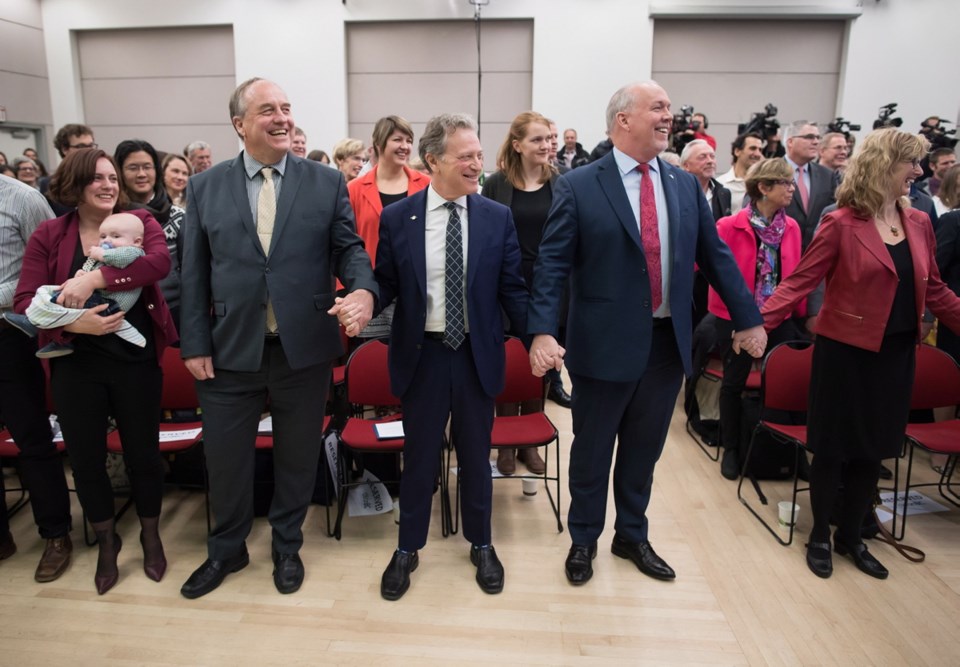The B.C. government will offer incentives to British Columbians who buy zero-emission vehicles and make their homes more energy-efficient, as part of its climate action plan to reduce greenhouse gas emissions.
The government will use revenue from the carbon tax to create incentives for the oil and gas sector to move away from fossil fuels and transition to renewable hydroelectricity to power their plants. Nearly three-quarters of the energy used across the B.C. economy still comes from fossil fuels, and the Clean B.C. plan aims to change that.
The climate-action plan was unveiled Wednesday by Premier John Horgan, Green Party Leader Andrew Weaver, Environment Minister George Heyman and Energy Minister Michelle Mungall at a news conference in Vancouver.
The province is also speeding up the switch to cleaner fuels at the gas pump, by increasing the production of renewable transportation fuels.
In the spring, the B.C. NDP government introduced new targets for slashing carbon pollution, with the goal of reducing greenhouse gas emissions by 40 per cent over the next 12 years, by 60 per cent by 2040, and by 80 per cent by 2050. The targets are based on 2007 emission levels.
If successful, the plan released Wednesday will take B.C. 75 per cent of the way to meeting the 2030 target. The remaining 25 per cent, Heyman said, will be identified through initiatives rolled out over the next 18 to 24 months.
Emissions in B.C. have risen in four of the past five years, Heyman said. “We’re seeing and living the effects of climate change,” he said, pointing to droughts, flooding and back-to-back wildfire seasons that were the worst in B.C.’s history. “These are all threats to our security, our economy and our health.”
Horgan gave credit to former premier Gordon Campbell, who in 2008 introduced the carbon tax, the first in North America.
In November, Horgan and Weaver announced that all new light-duty cars and trucks sold in B.C. must be zero-emission by 2040. The proposed legislation, to be introduced in the spring, will set sales targets for zero-emission vehicles, such as those fuelled by electricity or hydrogen. The government also committed to spending $57 million on an incentive program that offers up to $5,000 to people who buy or lease an electric or hybrid-electric vehicle.
The sector that emits the most greenhouse gases is transportation, at 37 per cent of emissions, followed by oil and gas at 22 per cent, and residential and commercial buildings at 12 per cent, according to the National Energy Board. B.C.’s emissions per capita are one of the lowest in Canada, at 12.8 tonnes of CO2, which is 36 per cent below the national average of 20.1 tonnes, National Energy Board figures show.
David Austin, an energy lawyer at Stirling LLP who has worked with the Clean Energy Association of B.C., said he’s long been advocating for the electrification of the oil and gas industry, which would require B.C Hydro to add transmission lines to get enough energy to gas fields. The Dawson Creek-Chetwynd transmission line delivers electricity to some natural gas producers, but it is fully subscribed. A second line, the Peace Region Electricity Supply project, is under construction.
“Our provincial government is finally getting serious about greenhouse gas reduction,” Austin said. “I’m baffled as to why it didn’t start sooner.”
B.C. Liberal environment critic Peter Milobar said the NDP’s climate change plan “continues to take British Columbia down a path first started by the B.C. Liberals.”
“It makes you question why it took the NDP and Greens a year to come up with a plan that is so similar to the one we originally designed,” he said. “Given that this plan continues to strive to meet our original dates and targets, the initiatives announced today are largely to be expected, and in the context of a climate-change plan, would be considered the more straightforward elements.”
Environmental groups hailed the plan as a “major step forward.” But a number of them remain unconvinced that the government can achieve its targets while continuing to expand a liquefied natural gas industry. “It’s a serious concern that B.C. isn’t reducing our carbon pollution as much or as fast as is needed to defend our communities from the climate impacts like the fires and the flooding that we’ve been seeing,” said Caitlyn Vernon, Sierra Club B.C.’s campaigns director. “It would be a lot easier to get to 100 per cent if LNG wasn’t in the mix.”
Geoff Morrison of the Canadian Association of Petroleum Producers described the Clean B.C. plan as “credible” and said the association was encouraged by the government’s commitment to providing the oil and gas industry with access to clean energy. “The single biggest thing that we can do is to electrify,” he said. “So if we can get affordable electrification going forward, that’s the place we can make a dent in changing the intensity of that fuel that we’re dependent on now.”
The Canadian Taxpayers’ Federation voiced concern about the lack of information on how much the climate plan will cost. “It was long on platitudes and short on prices,” said Kris Sims, the federation’s B.C. director. “I’m very worried this is going to cost the average person a lot of money.”
Heyman said February’s budget will provide details on how much the plan will cost. “Our plan will be fully funded,” he said. “In addition to that, we’ll be accountable for how we spend the carbon tax money; we’ll be accountable in each ministry about what we’re spending on programs to reduce emissions.”
In 2015, B.C. emitted about 63 million tonnes of greenhouse gases, about five per cent less than in 2007, according to data from Renewable Cities, a program run by the Simon Fraser University Morris J. Wosk Centre for Dialogue. The program said to meet its 2030 target, B.C. must cut greenhouse gases by about 26.5 million tonnes.



